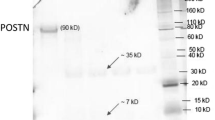Abstract
The aim of this study was to develop a routine and reliable radioimmunoassay (RIA) for dog osteocalcin. Two peaks of dog osteocalcin were purified to apparent homogeneity according to N-terminal sequence analysis. Amino acid composition analysis suggested that the second peak was intact dog osteocalcin whereas the first peak could be a truncated molecule. High titer (>1:5,000) anti-dog osteocalcin antisera were produced in rabbits. The antiserum recognized dog and rat osteocalcins but not that in serum of human, bovine, rabbit, mouse, guinea pig, or goat. A homologous RIA using anti-dog osteocalcin as the antibody and dog osteocalcin as the tracer and standard was developed. Taking advantages of the facts that (1) anti-dog osteocalcin crossreacted in parallel with rat osteocalcin and (2) purified rat osteocalcin is commercially available, we devised an approach that used rat osteocalcin as the tracer and standard, and anti-dog osteocalcin as the antibody to develop a heterologous RIA. This assay recognized dog serum osteocalcin and diluted in parallel with rat and dog osteocalcins. Quantitation was done using rat osteocalcin to construct standard curves, and results were expressed in ng/ml of rat osteocalcin-equivalent. The detection limit of the assay was 5 ng/ml rat osteocalcin-equivalent, and half-maximal displacement was seen at 30–40 ng/ml rat osteocalcin-equivalent. The inter-and intraassay variations were 16.1% and 8.5%, respectively. The assay accurately determined the amount of exogenously added dog osteocalcin in serum. The results quantitated with this RIA correlated well (r-0.975, n=86) with those obtained with the homologous RIA. Application of the heterologous assay to dogs of different age revealed that young dogs (3 months old) had 15-fold higher serum osteocalcin level than adult (>2 years old) dogs. In summary, we have (1) purified dog osteocalcin; (2) produced an antiserum against it; and (3) developed a heterologous RIA that could accurately measure dog osteocalcin, and could be used routinely to measure dog osteocalcin.
Similar content being viewed by others
References
Kraenzlin ME, Taylor AK, Baylink DJ (1989) Biochemical markers for bone formation and bone resorption. In: Lindh E, Thorell JI (eds) Clinical impact of bone and connective tissue markers, Harcourt Brace Jovanovich Ltd, Orlando, FL, pp 289–303
Price PA, Otsuka AS, Poser JW, Kristaponis J, Raman N (1976) Characterization of a γ-carboxyglutamic acid-containing protein from bone. Proc Natl Acad Sci USA 73:1447–1451
Brown JP, Malaval L, Chapuy MC, Delmas PD, Edouard C, Meunier PJ (1984) Serum bone Gla-protein: a specific marker for bone formation in postmenopausal osteoporosis. Lancet 1: 1091–1093
Greenwood FC, Hunter WM, Glover JS (1963) The preparation of 131I-labelled human growth hormone of high specific radioactivity. Biochem J 89:114–123
Rodbard D (1974) Data processing for radioimmunoassays: an overview. In: Natelson S, Pesce AJ, Dietz AA (eds) Clinical chemistry and immunochemistry: chemical and cellular bases and applications in disease. American Association of Clinical Chemists, Washington, DC, pp 477–494
Colombo G, Fanti P, Yao C, Malluche HH (1993) Isolation and complete amino acid sequence of osteocalcin from canine bone. J Bone Miner Res 8:733–743
Nakade O, Kaku T, Matsuyama T (1993) Primary structure and immunohistochemical localization of dog osteocalcin. Jpn J Oral Biol 35:237–250
Patterson-Allen P, Brautigam CE, Grindeland RE, Asling CW, Callahan PX (1982) A specific radioimmunoassay for osteocalcin with advantageous species cross-reactivity. Anal Biochem 120:1–7
Hauschka PV, Carr SA (1982) Calcium-dependent alpha-helical structure in osteocalcin. Biochemistry 21:2538–2547
Vanderschueren D, Gevers G, Raymaekers G, Devos P, and Dequeker J (1990) Sex- and age-related changes in bone and serum osteocalcin. Calcif Tissue Int 46:179–182
Lian JB, Gundberg CM (1988) Osteocalcin-biochemical considerations and clinical applications. Clin Orthop Rel Res 226:267–291
Fanti P, Colombo G, Yao C, Brown SA, Vernon MW, Malluche HH (1993) Development and characterization of a polyclonal antiserum-based radioimmunoassay for dog osteocalcin. J Bone Miner Res 8:745–752
Hauschka PV (1986) Osteocalcin: the vitamin K-dependent Ca2+-binding protein of bone matrix. Haemostasis 16:258–272
Kiefer MC, Saphire ACS, Bauer DM, Barr PJ (1990) The cDNA and derived amino acid sequences of human and bovine bone Gla protein. Nucleic Acids Res 18:1909
Author information
Authors and Affiliations
Rights and permissions
About this article
Cite this article
Wang, S.P., Demarest, K.T., Gunnet, J.W. et al. Development of a heterologous radioimmunoassay for canine osteocalcin. Calcif Tissue Int 55, 134–140 (1994). https://doi.org/10.1007/BF00297189
Received:
Accepted:
Issue Date:
DOI: https://doi.org/10.1007/BF00297189




